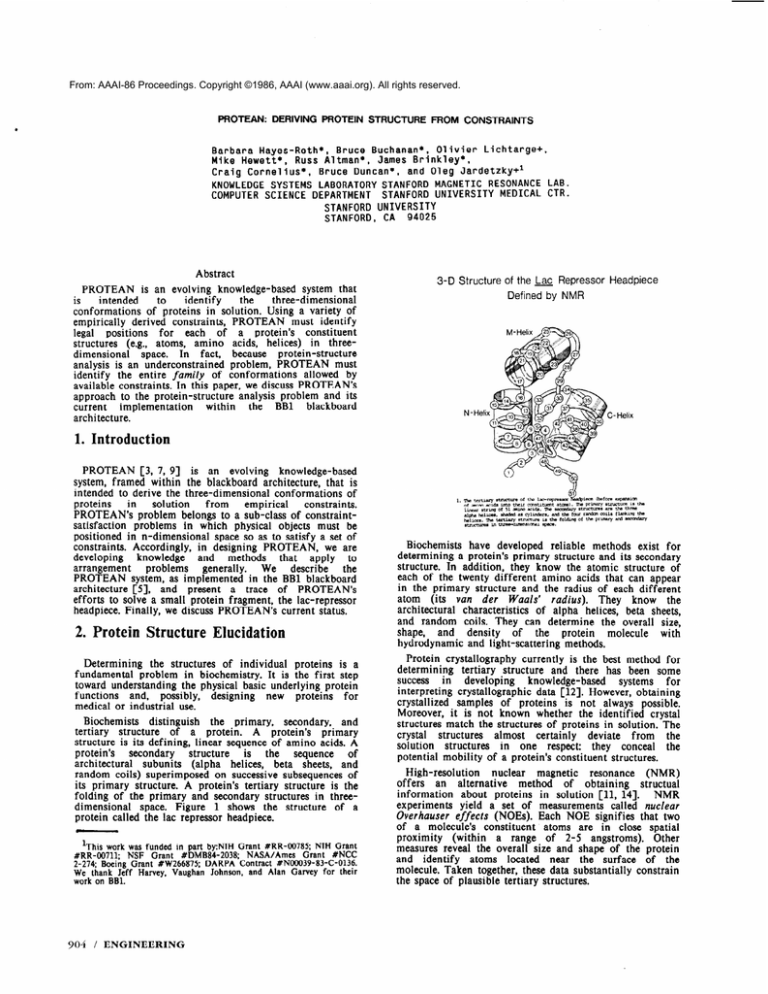
From: AAAI-86 Proceedings. Copyright ©1986, AAAI (www.aaai.org). All rights reserved.
PROTEAN:
DERIVING
PROTEIN
STRUCTURE
FROM
CONSTRAINTS
Barbara
Hayes-Roth*,
Bruce
Buchanan*,
Olivier
Lichtarge+.
Mike
Hewett*,
Russ
Altman*,
James Brinkley*,
Craig
Cornelius*,
Bruce
Duncan*,
and Oleg
Jardetzky+l
KNOWLEDGE
SYSTEMS
LABORATORY
STANFORD
MAGNETIC
RESONANCE
COMPUTER
SCIENCE DEPARTMENT
STANFORD
UNIVERSITY
MEDICAL
STANFORD
UNIVERSITY
STANFORD,
CA
94025
Abstract
PROTEAN
is an evolving knowledge-based
system that
identify
the
three-dimensional
is
intended
to
conformations
of proteins in solution. Using a variety of
empirically
derived constraints, PROTEAN
must identify
for each of a protein’s
constituent
legal positions
amino acids, helices) in threestructures (e.g., atoms,
dimensional
space. In fact, because protein-structure
analysis is an underconstrained
problem, PROTEAN
must
identify the entire family of conformations
allowed by
available constraints. In this paper, we discuss PROTEAN’s
approach to the protein-structure
analysis problem and its
within
the BBl
blackboard
current
implementation
architecture.
3-D
Structure
N-Heli
LAB.
CTR.
of the &
Repressor
Defined
by NMR
Headpiece
C-Helix
1. Introduction
PROTEAN [3, 7, 91 is an evolving
knowledge-based
system, framed within the blackboard architecture, that is
intended to derive the three-dimensional
conformations
of
proteins
in
solution
from
empirical
constraints.
PROTEAN’s problem belongs to a sub-class of constraintsatisfaction problems in which physical objects must be
positioned in n-dimensional
space so as to satisfy a set of
constraints. Accordingly,
in designing PROTEAN,
we are
developing
knowledge
and methods
that apply
to
arrangement
problems
generally.
We describe
the
PROTEAN system, as implemented in the BBl blackboard
architecture [S]. and present a trace of PROTEAN’s
efforts to solve a small protein fragment, the lac-repressor
headpiece. Finally, we discuss PROTEAN’s current status.
2. Protein Structure Elucidation
Determining
the structures of individual
proteins is a
fundamental
problem in biochemistry. It is the first step
toward understanding the physical basic underlying protein
functions
and, possibly, designing
new proteins
for
medical or industrial use.
Biochemists
distinguish
the primary,
secondary, and
tertiary
structure of a protein.
A protein’s
primary
structure is its defining, linear sequence of amino acids. A
protein’s
secondary
structure
is the sequence
of
architectural
subunits (alpha helices, beta sheets, and
random coils) superimposed on successive subsequences of
its primary structure. A protein’s tertiary structure is the
folding of the primary and secondary structures in threedimensional
space. Figure 1 shows the structure of a
protein called the lac repressor headpiece.
l
‘This work was funded in part by:NIH Grant #RR-00785;
NIH Grant
#RR-00711;
NSF Grant
#DMB84-2038;
NASA/Ames
Grant #NCC
2-274; Boeing Grant #W266875;
DARPA Contract #NOOO39-83-C-0136.
We thank Jeff Harvey, Vaughan Johnson, and Alan Garvey for their
work on BBl.
904
/ ENGINEERING
Biochemists have developed reliable methods exist for
determining a protein’s primary structure and its secondary
structure. In addition, they know the atomic structure of
each of the twenty different amino acids that can appear
in the primary structure and the radius of each different
atom (its van der W&s’
radius).
They know the
architectural
characteristics of alpha helices, beta sheets,
and random coils. They can determine the overall size,
shape, and density
of the protein
molecule
with
hydrodynamic and light-scattering
methods.
Protein crystallography
currently is the best method for
determining
tertiary structure and there has been some
success in developing
knowledge-based
systems for
interpreting
crystallographic
data [12]. However, obtaining
crystallized samples of proteins is not always possible.
Moreover, it is not known whether the identified
crystal
structures match the structures of proteins in solution. The
crystal structures
almost certainly
deviate from
the
solution
structures in one respect: they conceal the
potential mobility of a protein’s constituent structures.
High-resolution
nuclear
magnetic
resonance (NMR)
offers an alternative
method of obtaining
structual
information
about proteins in solution [ll, 141. NMR
experiments yield a set of measurements called nuclear
Overhauser effects (NOES). Each NOE signifies that two
of a molecule’s constituent
atoms are in close spatial
proximity
(within
a range of 2-5 angstroms). Other
measures reveal the overall size and shape of the protein
and identify
atoms located near the surface of the
molecule. Taken together, these data substantially constrain
the space of plausible tertiary structures.
Efforts
to develop computer
programs for deriving
protein
structure
from NMR data have focused on
distance geometry algorithms that minimize the value of
some distance
error
function [14, 13, 1, 151. These
approaches suffer two major limitations. First, since NMR
data are sparse, they do not identify a unique solution for
a given protein. Existing
programs do not thoroughly
explore the “conformational
space” of solutions
that
satisfy a given set of constraints. Instead, they explore a
local region of solutions
around a plausible
starting
structure.
Second, existing
programs
treat potential
mobility in a very limited fashion. They may hypothesize
minor mobility of small substructures (such as amino acid
sidechains), while failing to consider major mobility
of
larger substructures (such as helices).
solid level, it reasons about the protein’s constituent
alpha-helices,
beta-sheets, and random coils, representing
these structures as geometric cylinders, prisms, and spheres.
At the superatom level, it reasons about the protein’s
constituent
amino
acids, in terms of peptide
units
(represented
as prisms) and sidechains (represented
as
spheres). Finally, at the atom level, PROTEAN
reasons
about the protein’s individual
atoms. When PROTEAN
reasons top-down, it uses the hypothesized position of a
structure at one level to restrict its examination
of
positions of constituent structures at a lower level. When
PROTEAN
reasons bottom-up,
it uses the hypothesized
position of a structure at one level to restrict the position
of its superordinate
structure. Since most of the current
implementation
operates at the Solid level, we have not
yet explored the full power of bidirectional
reasoning.
3. Approach
PROTEAN
is intended to surmount the limitations
of
existing methods for elucidating
protein structure from
must: identify the furnil? of
NMR data. Thus, zET$AN
available
constraints;
conformations
by
incorporate all available constraints to restrict the family
as much as possible; and characterize the mobility
of
protein substructures allowed by the constraints.
In so
doing, it must cope with the large, combinatoric
search
space entailed in protein-structure
analysis.
PROTEAN’s
fundamental
operation is to identify and
then refine the family of positions in which a structure
Successively
satisfies a designated set of constraints.
restrict
the family
successively
constraints
applied
hypothesized for a given structure. We have identified .a
variety of potentially
useful constraints
on protein
structure (see Table 1). Some of these are local constraints,
such as NOE data signifying the proximity of a particular
pair of atoms. Others are global constraints, such as
molecular size. By combining these qualitatively different
kinds of constraints, PROTEAN should be able to restrict
the space of possible protein conformations.
m-----v
Table
1. Some of the
Available
Constraints
_____-_________-____-------__________
on Protein
Structure
-e-v_---_--__-__-_--_____--
Primary
structure
Atomic
structures
of
individual
radii
of
individual
van
der Uaals’
Peptlde
bond
geometry
Secondary
structure
Architectures
of alpha-helices
Molecular
size
Molecular
shape
Molecular
density
NOE measurements
Surface
data
amino
acids
atoms
and
beta-sheets
PROTEAN must consider two factors in reasoning about
structural mobility.
First, it must infer mobility whenever
it finds that no position for a structural subunit (such as
a helix) satisfies a set of applicable constraints. Second, it
must incorporate user-specified
hypotheses that particular
sets of constraints are or are not satisfied simultaneously
in a single conformation.
In both cases, PROTEAN
must
reason about alternative families of positions for affected
structures under non-simultaneous
constraint sets.
To reduce the combinatorics
of search, PROTEAN
adopts a “divide-and-conquer”
approach. It defines partial
solutions that incorporate different subsets of a protein’s
and different
subsets of its
constituent
structures
constraints. It focuses first on satisfying constraints within
each partial solution, positioning each structure relative to
a single fixed structure. After substantially restricting the
two overlapping
partial
positions
of structures within
solutions, PROTEAN applies constraints between them.
Also to reduce search combinatorics, PROTEAN reasons
bidirectionally
across different
levels of abstraction (see
Figure 3). At the molecule level, PROTEAN reasons about
the overall size, shape, and density of the molecule. At the
PROTEAN’S
LEVELS
OF
REASONING
We envision a basic successive refinement strategy, with
some opportunistic
deviation.
Thus, PROTEAN
should
reason reason top-down through the levels of abstraction,
with some bottom-up
adjustment of results. It should
apply this strategy simultaneously
to several overlapping
partial solutions, integrating them only after it has applied
all or most of their internal
constraints. Within
this
still faces an extensive
general strategy, PROTEAN
solution space and must reason more specifically about the
most efficient
order in which to apply individual
constraints to individual
structures in particular
partial
solutions. We have implemented
a strategy that combines
domain-independent
computational
principles
(e.g.,
choosing
partial-solution
“anchors”
that have many
constraints to many other structures; focusing on structures
that have been restricted to small families; and preferring
strong constraints)
with biochemistry
knowledge
(e.g.,
defining the space of potentially
useful constraints; and
characterizing
the constraining
power
of different
Since intelligent
control
is a critical
constraints).
component of effective problem-solving
in PROTEAN, we
plan to experiment with these and other control strategies.
4. Current Implementation
We are developing
PROTEAN
within
the BBl
blackboard architecture [ 51, which defines: (a) functionally
independent
problem-solving
knowledge
sources
to
generate and refine solution elements: (b) a multi-level
solution blackboard
on which these knowledge sources
record evolving solutions; (c) control knowledge sources to
reason about problem-solving
strategy; (d) the BBl control
blackboard on which control knowledge sources record the
evolving control plan; and (e) an adaptive scheduler that
AUTOMATED
REASONING
! 905
uses the current
control
knowledge
source should
problem-solving
cycle.
plan to determine
which
execute its action on each
How
BBl Works
Blackboard representation
lac-repressor
headpiece.
of a partial
solution
for
the
PROTEAN’s
current problem-solving
knowledge sources
(see Table 2) define partial solutions at the Solid level
and position alpha-helices
and random coils relative to
one another within those partial solutions. Although the
current implementation
of PROTEAN
has only eleven
problem-solving
knowledge sources, it instantiates most of
them many times for a single protein. For example, the
knowledge source Anchor-Helix
generates different KSARs
for different
anchor-anchoree
pairs and for different
constraints between a given pair.
A BBl system (see Figure 3) iterates the following
steps:
1. An action (called a KSAR or knowledge source
activation record) is executed, causing changes
to elements
on the solution
or control
blackboard.
2. These blackboard changes trigger one or more
problem-solving
or control knowledge sources,
placing new KSARs on the agenda. Each KSAR
instantiates
an action
definition
from
a
knowledge source in the context of the current
problem-solving
state.
3. The scheduler chooses the pending KSAR that
best satisfies the current control plan.
Thus, BBl provides a uniform.
integrated blackboard
mechanism
for reasoning
about the solution
to the
problem at hand as well as about the problem-solving
process per se.
PROTEAN
currently
uses a four-level
solution
blackboard, including
the levels in Figure 2. Figure 4
shows a partial solution for the lac-repressor headpiece at
the Solid level of the blackboard.
The example also
illustrates PROTEAN’s
language of partial solutions. All
structures within a partial solution are positioned relative
to a uniquely-positioned
anchor.
In Figure 4, Helix1 is
the anchor. When PROTEAN
applies constraints between
the anchor and another structure, it anchors an anchoree.
In Figure 4, Helix1 anchors five anchorees, Coill, Coil2.
Helix2, Helix3, and Coi14.
When PROTEAN
applies
constraints between an anchoree and a structure that has
no constraints with the anchor, it appends an appendage.
In Figure 4, Hexli2 appends an appendage, Coi13. When
PROTEAN
applies constraints between two anchorees or
appendages, it yokes them. In Figure 4, for example,
Helix2 and Helix3 yoke one another.
906 / ENGINEERING
Table
2.
PROTEAN's
Eleven
Problem-Solving
____________--___-------------------------------------------------------Knowledge
Source
Knowledge
Sources
Behavior
Post-the-Problem
Retrieves
the
description
of a test
protein
and associated
constraints
from
a data
file
and posts
them
on the
blackboard
in a form
that
is Interpretable
by other
PROTEAN
knowledge
sources.
Post-Solid-Anchors
Creates
obiects
that
reoresent
and describe
the
detail;
of all
of
the
test-protein's
secondarv
structures
(aloha-helices
and random
coils).
kach
one is a'poiential
anchor
for
a
solution.
Activate-Anchor-Space
Chooses
anchor
of
a particular
a partial
solld-anchor
solution.
to
be
the
Add-Anchoree-toAnchor-Space
Chooses
a particular
solid-anchor
It
as a token
object
that
copier
solid-anchor)
to be an anchoree
established
anchor-space.
Express-MOE-Constraint
IdentItles
the
the
MOE contact
while
satlsfylng
Express-CovalentConstraint
Identifies
the
tarlly
site
of
a covalent
to another
structure
Express-TetherConstraint
Identifies
Site
of
another
the
family
of positions
in which
the
a covalent
bond connecting
a structure
to
structure
via
a short
random
co11
can
lie.
Anchor-Helix
Identifies
can
lie
with
an
previously
the
tamlly
while
satisfying
anchor,
along
applied
to
Anchor-Coil
Identifies
anchoree
constraints
constraints
Append-Helix
IdentItles
appendage
constraints
constraints
Yoke-Helices
Restricts
for
two
constraints
family
site
an
of
positions
of
a structure
MOE with
another
of posltions
bond connecting
can 118.
of
with
It.
in
which
can lie
structures.
in which
a structure
positions
in which
one or more
constraints
all
constraints
the
can
(representing
the
chosen
in a previously
family
of
positions
lie
while
satistylng
with
an anchor,
along
previously
applied
to
in
one
with
it.
the
a helix
which
a coil
or more
tether
all
the
tamlly
of positions
In which
a helix
can lie
while
satisfying
one or more
with
an anchoree.
along
with
all
previously
applied
to It.
the
helix
established
tamllles
anchorees
to satisfy
between
them.
of posItionS
one or more
Anchor-Coil,
Three knowledge sources, Anchor-Helix,
and Yoke-Structures,
rely upon a set of numerical
functions called the geometry system or GS [Z]. The GS
represents the position of each structure as a set of six
parameters. Three parameters place the structure at a
particular
location
in the three-dimensional
coordinate
space and three parameters orient the strucuture about its
own axes. The GS explores all values of the parameters at
some level of resolution, determining
whether a designated
structure positioned
with those values can satisfy the
designated constraints.
PROTEAN
currently
operates under the following
problem-solving
strategy:
1. Establish the longest, most constraining
helix
as the anchor.
2. Position all other secondary structures in the
protein relative to the chosen anchor, giving
priority to actions that apply strong constraints
to structures that are helices, that are long, that
constrain many other structures, and that have
many constraints with the anchor.
Working
within
the BBl
architecture,
PROTEAN
represents this strategy as a hierarchy of decisions on the
control blackboard (see Figure 5). At the strategy level,
PROTEAN
records a decision to use this particular
strategy, along with the information
it needs to generate
the prescribed sequence of steps at the appropriate
time.
PROTEAN records the steps as individual
decisions at the
focus level, encompassing sequential problem-solving
time
intervals. Each focus decision also records the information
PROTEAN
needs to generate the associated heuristics,
which it records as decisions at the heuristic level. Each
heuristic encompasses roughly the same time interval as its
superordinate focus decision.
Table
3.
PROTEAN's
__--______---____-----------------
Knowledge
Source
Sixteen
Control
Knowledge
Sources
- - - - _ - - - - ___-------_--_-_-_------------
Behavior
_________________-__----------------------------------------------------Generic
BBI Control
Knowledge
________-________---____________________--------------------------------Initialize-Focus
Identifies
by a newly
the
initial
recorded
Update-Focus
Identifies
by a strategy,
each
Terminate-Focus
Changes
the
the
focus's
Terminate-Strattegy
Changes
when
the
status
goal
Sources
focus
strategy
prescribed
subsequent
ibed
prescr
of
a focus
satisfied.
of
a strategy
to
goal
is satisfied.
is
the
status
strategy's
focus
to
"inoperative"
"inoperatlve"
_______--________--_----------------------------------------------------Domain-Specific
Control
Knowledge
__________----___-__-----------------------------------------------------
Sources
Develop-PS-ofBest-Anchor
Records
the
develop-ps-of-best-anchor
Create-BestAnchor-Space
Records
the
create-best-anchor-space
Position-All-Structures
Records
the
posltlon-all-structures
Prefer-Helix>Sheet>Coll
-Anchors
Records
a heuristic
that
gives
high
ratings
To KSARs
that
operate
on helix
anchors,
intermediate
ratings
to KSARs
that
operate
on
beta-sheet
anchors.
and low
ratings
to KSARs
that
operate
on random
coil
anchors.
Prefer-Long-Anchors
Records
a heuristic
to
KSARs
that
operate
that
on
strategy.
focus.
focus
gives
long
higher
anchors
ratings
Prefer-StronglyConstraining-Anchors
Records
a heurlstlc
that
gives
higher
ratings
to KSARs
whose
anchors
have
many
constraints
with
many
other
structures.
Prefer-strateglcallySelected-Anchor
Records
KSARs
anchor.
Prefer-Hellx>Sheet>Coil
-Anchoree
Records
a heuristic
that
gives
high
ratings
to KSARs
that
operate
on helix
anchorees.
intermediate
ratings
to KSARs
that
operate
on
beta-sheet
anchorees.
and low
ratings
to KSARs
operate
on random
coil
anchorees.
Prefer-Long-Anchoree
Records
KSARs
Prefer-StronglyConstrained-Anchoree
Records
a heurlstlc
to KSARs
that
operate
that
a heuristic
operate
that
gives
higher
ratings
on the
strategically-selected
a heuristic
that
operate
constraints
with
that
gi ves higher
on long
anchorees.
the
that
on
ratings
many
anchor.
Records
a heuristic
that
gives
higher
ratings
to KSARs
that
operate
on anchorees
that
have
many
Constraints
with
other
anchorees.
Prefer-StrongConstraint
Records
KSARs
a heuristics
apply
that
to
gives
higher
ratings
anchorees
that
have
Prefer-MutuallyConstraining-Anchoree
that
to
that
strong
gives
constraints.
higher
ratings
to
5. Example: PROTEAN’s Partial Sohtion
of the Lac-Repressor Headpiece
The lac-repressor headpiece is a protein with fifty-one
amino acids. Its true structure is unknown, but NMR data
are available for it and several research groups have
partially
identified
its structure [lo, 81. Interpreted
data
for the lac-repressor are shown in Table 4. This section
describes the first 25 cycles of a program
trace of
PROTEAN’s efforts to solve the lac-repressor headpiece.
PROTEAN
generates its strategy incrementally,
one
decision at a time, with the sixteen control knowledge
described in Table 3. Four of these are generic BBl
control knowledge sources: Initialize-Focus,
Update-Focus,
and Terminate-Strategy.
The other
Terminate-Focus,
twelve control knowledge sauces are domain-specific.
The
next section illustrates PROTEAN’s use of the knowledge
sources to control its efforts to solve a small protein, the
lac-repressor headpiece.
Table
4.
Interpreted
Data
for
the
Amino
acids
are
numbered
sequentjally
in
named
according
to biochemical
conventions.
IS the
second
amino
acid
in the
sequence
identify
particular
atoms
within
particular
are within
2-5
angstroms
of
one another.
specifies
the
atom
3 of Valine
4 is within
of
tyrosine
17.
Data
Type
Data
Lx-Repressor
Headpiece
the
primary
structure
and
LYSE.
for
example,
and is a lysine.
NOES
amino
acids
that
For example.
NOE 1
2-5 angstroms
of
at oil 5
Value
PROTEIN-NAME
LAC-REPRESSOR-HEADPIECE
PRIMARY-STRUCTURE
MET1 LYS2 PRO3 VAL4
THR5 LEU6
TYR7
ASPB VAL9
ALA10
GLUII
TYR12
ALA13
GLY14 VALl5
SERIG
TYR17
GLNlB
THRIS
VALLO
SERLI
AR622
VAL23
VAL24
ASN25
GLN26 ALA27
SER28
HIS29
VAL30
SER31
ALA32
LYS33
THR34
ARG35 GLU36
LYS37
VAL38
GLU39
ALA40
ALA41
MET42 ALA43
GLU44
LEU45
ASN46
TYR47
ILE48
PRO49 ASNCO ARG51))
AUTOMATED
REASONING
i 907
SECONDARY-STRUCTURE
NOES
(Coil1
(Helix1
Coil2
Helix2
Coil3
Helix3
(Coil4
1 VAL4
3 VAL4
MET1 THR5)
LEU6 GLY14)
VAL15
SER16
TYR17
ASN25
GLN26 ARG35
GLU36
LEU45
ASN46
ARG51
3 TYR17
3 TYR47
5
5
(
I
t
I 75 LEU6
4 MET42
TYR17
55
9 TYR7
5 TYR17
5)
11 VAL9
3 MET42
5
13 VAL9
3 TYR47
5 1
15 ALA10
2 VALPO
3)
17 TYRlP
5 ALA40
2)
19 TYRlP
5 MET42
5)
(21 TYRlE
5 LEU45
4)
(23 ALA13
2 ALA41
2)
(25 TYR17
5 MET42
5)
(27 VAL24
3 TYR47
5)
(29 MET42
5 TYR47
5)
2 VAL4
3 LEU45
4)
4 THRB 3 TYR47
5)
6 LEU6 4 VAL24
3)
6 LEU6 4 TYR47
5)
10 ASP6
3 LEU45
4)
(12 VAL9
3 LEU45
4)
(14 ALA10
2 TYR17
5)
(16 TYRlP
5 ALA32
2)
(18 TYR12
5 ALA41
2)
(20 TYRlZ
5 GLU44
4)
(22 ALA13
2 VAL38
3)
(24 VAL15
3 TYR47
5)
(26 VALZO
3 VAL38
3)
(28 VALBO
3 MET42
5)
Post-the-Problem
initiates PROTEAN
activity at the
Molecular
level by recording
a new protein-analysis
problem and all available constraints. This event triggers
and Developtwo knowledge sources: Post-Solid-Anchors
PS-of-Best-Anchor.
Since there are no control heuristics on the control
i:;kboard
yet, the scheduler uses the default schedulmg
It schedules and executes
: Prefer-Control-KSs.
which records PROTEAN’s
Develop-PS-of -Best-Anchor,
strategy (see Figure 5). This event triggers TerminateStrategy, which will not be executable until the strategy’s
below)
is satisfied. It also triggers
goal (explained
Initialize-Focus.
The scheduler chooses Initialize-Focus,
which uses the
strategy’s generator to identify the first focus it prescribes.
It records the name of that focus, “Create-Best-AnchorSpace,” as the strategy’s current-focus.
This event triggers
Create-Best-Anchor-Space.
The scheduler chooses Create-Best-Anchor-Space,
which
records the corresponding
focus (see Figure 5). This event
three control knowledge sources whose names are
listed as the new focus decision’s heuristics:
Preferand
Prefer-Long-Anchors,
Helix>Sheet>Coil-Anchors,
Prefer-Strongly-Constraining-Anchors.
It also triggers
Terminate-Focus,
which will not become executable until
the new focus’s goal is satisfied.
On the next three cycles, the scheduler chooses three
pending KSARs, each of which records a heuristic (see
Figure 5). These events do not trigger any new knowledge
sources.
The scheduler chooses the only pending KSAR, Postanchor
which
creates
a potential
Solid-Anchors,
representing each secondary structure in the protein. Each
of these events triggers a corresponding
KSAR involving
Create-Anchor-Space.
Now the scheduler uses the three heuristics posted on the
control blackboard
to determine which of the CreateAnchor-Space
KSARs to execute. Since Helix1 is the
longest, most constraining helix, it chooses the KSAR that
creates an anchor space for Helix1 (see Figure 4). This
event satisfies the goal of the Create-Best-Anchor-Space
focus (the best anchor space has been created), thereby
making the corresponding
KSAR for Terminate-Focus
executable. The event also triggers the knowledge
source
Add-Anchoree-to-Anchor-Space
once for
each other
secondary structure in the protein.
The scheduler chooses Terminate-Focus,
which changes
the status of the existing focus and its subordinate
It also records the focus name,
heuristics to “inoperative.”
“Create-Best-Anchor-Space,”
as the strategy’s expiredFocus. This event triggers the control knowledge source
Undate-Focus.
The scheduler chooses Update-Focus,
which uses *the
strategy’s generator to identify the next focus it prescrrbes
and records the name of that focus, “Position-AllThis event
Structures,” as the strategy’s current-Focus.
triggers the knowledge source Position-All-Structures.
triggers
908
/ ENGINEERING
The scheduler chooses Position-All-Structures,
which
records the corresponding
focus (see Figure 5). This event
triggers the knowledge source Terminate-Focus,
which will
not become executable until its goal is satisfied.
The
event also triggers the six control knowledge
sources
named in the new focus decision’s heuristics: PreferStrategically-Selected-Anchor,
Prefer-Helix>Sheet>CoilAnchorees,
Prefer-Long-Anchorees,
Prefer-StronglyConstrained-Anchorees,
Prefer-Mutually-ConstrainingAnchorees, and Prefer-Strong-Constraints.
On the next six cycles, the scheduler chooses KSARs that
record heuristics for the new focus.. These events do not
trigger any new knowledge sources.
Now the scheduler uses the six new control heuristics to
choose pending KSARs. At this point, the agenda contains
only KSARs
involving
the knowledge
source AddAnchoree-To-Anchor-Space.
The scheduler chooses the
KSAR that adds Helix3 (see Figure 4). This event triggers
several KSARs for Express-NOE-Constraint,
one for each
of the NOES between Helix1 and Helix3.
The scheduler
chooses a series of Express-NOEConstraint
KSARs. Each one records the family
of
positions in which the NOE contact site on Helix3 can lie,
relative
to Helixl.
Each ‘of these events triggers a
corresponding
KSAR for the knowledge source AnchorHelix.
The scheduler continues using the six control heuristics
to choose pending problem-solving
knowledge sources,
including
many different
triggerings
of the knowledge
sources: Add-Anchoree-to-Anchor-Space,
Express-NOEConstraint,
Express-Tether-Constraint,
Anchor-Helix,
Anchor-Coil,
and Yoke-Structures.
Each such action
triggers new KSARs, which are added to the agenda and
compete for scheduling priority.
All of these?r KSARs
together position all secondary structures relative to Helix1
with all applicable constraints (see Figure 4).
Because the results of these actions satisfy the goal of
the Position-All-Structures
goal (all structures have been
positioned), Terminate-Focus
becomes executable and the
scheduler chooses it. Terminate-Focus
changes the status
of the current focus and its associated heuristics to
“inoperative.”
It also records the focus name as the
strategy’s expired-Focus. This event triggers Update-Focus.
The scheduler chooses Update-Focus,
which uses the
strategy’s generator to identify the next focus it prescribes,
which in this case is “None,” and records it as the
strategy’s current-focus.
This event satisfies the strategy’s
goal and makes the pending Terminate-Strategy
KSAR
executable.
The scheduler chooses Terminate-Strategy,
which changes
the strategy’s status to “inoperative.”
In performing the actions summarized above, PROTEAN
produces a solid-level
solution
for the lac-repressor
headpiece, specifying the positional families within which
each of the protein’s secondary structures can lie while
satisfying the applicable constraints. PROTEAN’s solution
closely matches the manually identified solution described
in [S].
6. Current Status of PROTEAN
The
current
PROTEAN
system demonstrates
the
appropriateness of the blackboard architecture for proteinstructure analysis. Although PROTEAN
currently reasons
only about helices and random coils, we anticipate that the
its representational
conventions and geometric reasoning
methods will apply to other protein structures as well.
The current system incorporates reasoning about a variety
of constraints:
the known architectures
of helices,
covalent bonds, NOES, the known
architectures of amino-
acid sidechains, and van der Waals’ radii.
However, we
anticipate
a need to introduce
qualitatively
different
representational
conventions
and geometric
reasoning
methods to handle the global constraints on the overall
size, shape, and density of the molecule.
The blackboard
architecture
easily
incorporates
different
solution
representations
at different
blackboard
levels
and
incorporates
different
methods
in its functionally
independent knowledge sources.
The current system also suggests that the BBl blackboard
control
architecture
will support the critical
control
reasoning PROTEAN must perform.
PROTEAN currently
uses a single control strategy that is well captured in
control knowledge sources and produces a perspicuous
control plan during problem solving. This strategy works
well enough for reasoning about the secondary structures
of a small protein
with a subset of the available
constraints. However, when reasoning about all constituent
structures in larger proteins with all available constraints,
PROTEAN will need a new strategy. It will have to reason
about multiple partial solutions and their relationships
to
one another. It will have to sequence its constraintsatisfaction
operations
intelligently
to
avoid
a
computationally
intractable
explosion
of hypothesized
structures. It will have to reason about alternative protein
conformations
corresponding
to constraints that are not
satisfied simultaneously. Since we do not know an optimal
general control algorithm
for this problem,
we must
experimentally
evaluate alternative control strategies. To
support this investigation,
we are developing
learning
mechanisms to aquire control
knowledge from experts
automatically [6] and to comparatively
evaluate different
control strategies. We are also developing
explanation
mechanisms
that explicate
the relationships
between
problem-solving
actions
and the underlying
control
strategy [4].
I?1
Elucidating
protein
PROTEAN.
Braun, W., Bosch, C., Brown, L.R., and Wutrich,
Biochemistry
PI
L-31
and
Biophysics
667,
I31
heuristic
solution
refinement
structures
method
of prqteins.
Technical Report, Stanford,
University, 1985.
Hayes-Roth,
BBI:
for
PI
for
and
structure
domain
binding
PI
Ca.:
of proteins
by
of the lac-
Ca.: Stanford
Jardetzky, O., Lane, A., Lefevre, J-F., Lichtarge, O.,
Hayes-Roth, B., and Buchanan, B.
Determination
of macromolecular
structure and
dynamics by NMR.
Proceedings
NiUR
of the NATO
Advanced
Study
in the Life Sciences
, 1985.
Institue:
Cl01 Kaptein, R., Zuiderweg, E.R.P., Scheek, R.M. and
Boelens, R.
Journal
WI
of Molecular
Advances
cm
in Protein
Cl41
Cl51
1985.
Chemistry
,
1970.
Terry, A.
Hierarchical
Cl31
182:179-182,
Biology
Roberts, G.C.K. and Jardetzky, 0.
control
of production
PhD thesis, UC, Irvine,
1983.
Wagner, G. and Wutrich
K.
of
Magnetic
Wutrich,
K.
Advances
in Protein
Zuiderweg,
Proceedings
Resonance
Chemistry
E.R.P., Kaptein,
of
80:5837-5841,
the National
systems.
33:675-679,
1979.
24:447-545,
1976.
R., and Wutrich,
K.
Academy
of Sciences
1983.
Ca.: Stanford
blackboard
learn
about
Hayes-Roth, B.
A blackboard
architecture
Intelligence
Hayes-Roth,
DNA
in
B.
An architecture
control,
explain,
behavior.
Artificial
constraints
deriving
systems
that
their
own
Technical Report HPP-84-16, Stanford,
Stanfd
University, 1984.
PI
The
repressor.
Technical Report, Stanford,
University, 1984.
journal
Buchanan, B., Hayes-Roth. B. Lichtarge, O., Altman,
R., Brinkley, J., Hewett, M., Cornelius, C., Duncan,
B., Jardetzky, 0.
from
Jardetzky, 0.
Definition
of the tertiary
NiUR:
1981.
Brinkley, J., Cornelius, C., Altman, R., Hayes-Roth,
B., Lichtarge, 0.. Buchanan, B.. and Jardetzky, 0.
Application
of constraint satisfaction techniques to
the determination
of protein tertiary structure.
1986.
The
Cdl
K.
structure
Technical Report KSL-85-35,
Stanford,
Stanford University, 1985.
References
Cl1
Hayes-Roth, B., Buchanan, B Lichtarge, O., Hewett,
M, Altman, R., Brinkley, J., Cornelius, C., Duncan,
B., Jardetzky, 0.
Ca.:
for control.
Journal
26:251-321,
1985.
B., and Hewett, M.
Learning
Control
Environment.
Heuristics
Technical Report HPP-85-2.
University, 1985.
in a Blackboard
Stanford,
Ca.: Stanford
AUTOMATED
REASONING
/
909




